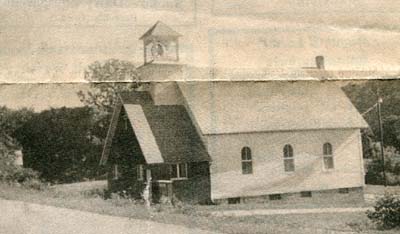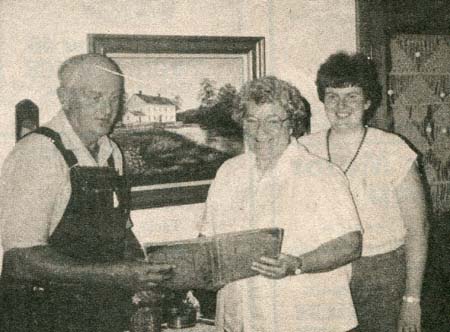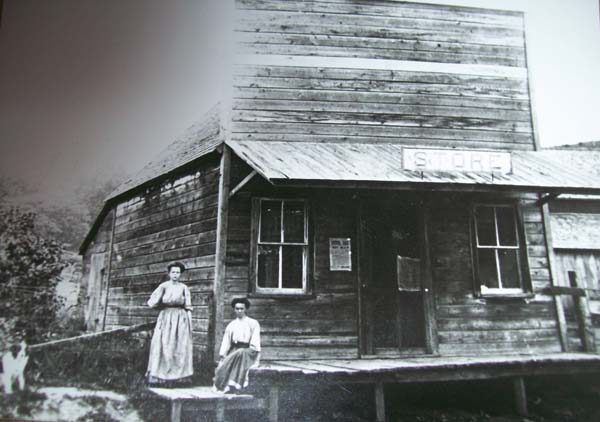Fields of corn fill the area which
once was the village of Forest Mills. The Yellow
River flows through the area and beyond the
cornfields are wooded areas. First known as Werhan's
Mill, the name was changed to Forest Mills when a
post office was established in July 1876. This
distribution center for patron's mail was in
operation until about 1901 when it was closed.
William Werhan was the postmaster. Werhan, whose
descendant, Lloyd Clark, still farms in the area,
came to this site in 1851. He built a sawmill in
partnership with P. M. Gilson. They constructed a
building 24 x 50. This alliance ended when Werhan
bought out Gilson. Werhan was an itinerant musician
in Germany. He wed the daughter of a nobleman which
caused them to be disowned. Then they emigrated to
America.
Lots of maple trees dotted the area and maple syrup
and maple sugar were the result of tapping the trees
on the Werhan farm. It is said that Werhan walked
eleven miles to Frankville, Iowa where he traded the
valuable maple syrup and sugar for broadaxes and
other tools. In addition to his ordinary business
duties, William Werhan was commissioned Justice of
the Peace. His duty was to keep strict order in the
village and to settle any disputes. He also ran the
general store which provided necessities for people
who lived close by.
The first waterpowered Jefferson Davis sawmill was
built in 1830 and being the businessman that he was,
William Werhan's first grist mill was constructed in
1865. At that time the demand for flour was great
since it was a basic ingredient in every diet. There
was a need for a larger and better grist mill. For
younger readers who may not know what a grist mill
is, an explanation is in order. Farmers hauled their
grain to the mill in a horse-drawn wagons in either a
wagon box or sacks. The miller would then grind the
grain and charge the farmers for his services.
However, the flouring industry was being overdone. In
1859 there were seven grist mills on Yellow River in
Franklin Township. By 1878 there were 25-30 grist
mills. This increase was due to the large grain crops
in the locality. In time there were many dropouts
because there was less demand for their services.
In December 1897 a United Brethren in Christ Church
became incorporated in Forest Mills. Actually, the
parish had been formed earlier, but the officers had
not been named. Trustees of the newly organized
parish were:
J.H. Hendrickson
C.W. Bender
Abe Evans
Henry Werhan
L.H. McGee
The United Brethren in Christ Church evolved into the
Forest Mills United Methodist Church which still
serves the spiritual needs of the community.
In the era of 1877-1902, Tangeman's had a mill in the
Forest Mills village but it was severely damaged by a
flood. It was then dismantled, moved to Monona and
rebuilt. At the turn of the century, the Yellow River
area was labeled the river of Lost Mills.
By 1901, 12 people lived in Forest Mills, according
to the county records. The need for education was
increasing, since many children from nearby farms
needed a place to attend classes. A one-room school
had been built in 1870 which taught grades 1-8. Later
as regulations changed, the kindergarten class had to
be added. Teachers provided the tutelage until 1957.
No doubt one of the teachers who stands out in the
mind of Forest Mills students is the Rev. Curtis
Webster. Rev. Webster taught at the Forest Mills
School in 1935-1941. From 1941-1953 he taught at the
nearby Volney School. He then taught at the nearby
Red School in Franklin Township from 1953 and until
it closed in 1967. After the closing of the Allamakee
rural schools, Rev. Webster taught 6th grade at the
Waukon Elementary School until his untimely death
four years ago on August 18, 1983 when he was killed
in a motorcycle accident. In addition to being a
teacher in the community, Curtis Webster became a
minister in 1939, and served the United Brethren in
Christ Church in Forest Mills. The United Brethren
Church changed its name to the United Methodist
Church and Rev. Webster continued to serve the Forest
Mills congregation and the congregation at the
Castalia United Methodist Church.

Forest Mills United Methodist church, 1987
Lloyd Clark, a grandson of William Werhan, was
generous in sharing family and area history for this
article. Having lived within five miles of Forest
Mills, Clark is an avid historian regarding Allamakee
county, and particularly the Forest Mills area. He
has many memories of the earlier days when he was a
boy. “I remember holding sacks to catch the
newly ground flour which had been sifted through silk
cloth. This removed any hulls or unevenly ground
grain. In those early days, fifty pounds of flour
could be bought for $1.25 but wages were low at that
time too.” Clark said. “A good corn husker
earned about 3 cents a bushel for picking,”
Clark continued. “This meant that an expert at
husking corn who would ordinarily husk 100 bushel a
day could only collect $3 a day plus his meal.”
In line with the economy before the turn of the
century, it cost $1 to haul a load of hogs to Waukon
to sell. A team of horses pulled the wagon across all
kinds of roads,” Clark remarked. “I made my
first money when we moved the schoolhouse across the
corner with horses. I made $16.50.”

Mr. & Mrs. Lloyd Clark and their
daughter, Carolyn display an antique ledger.
In the background is a picture of the original mill
at Forest Mills.
Lloyd Clark, his wife Marilyn, and daughter Carolyn,
are family historians as their home indicates. They
are the ones who carry on the heritage of the William
Werhan family. Walnut articles have been preserved
and refinished and make up part of the family
history. An antique organ which had been the property
of the United Brethren Church in Postville is an
artistic piece. A giant wardrobe that has been
refinished is a prized possession. Each article has a
story behind it. On a tour through their home a group
of vintage county atlases, valuable ledgers showing
prices years ago and genealogical books make up a
collection in an upstairs bedroom.
Carolyn, who has been very active in 4-H is employed
at Chet Barr's News in Lansing. She resides with her
parents. Three other daughters, Jane Lamborn, Nancy
Straate, and Diane Rissman live with their families
on area farms. The Clarks have three grandsons and
four granddaughters. The Cark ladies are noted for
their expertise in quilt making and the actual
quilting practice. Many sewn quilts were displayed as
well as those which had not been completed. “The
girls share designs, ideas, and patterns. When one
masters a sewing project, she teaches the others how
to do it. I am in charge of a quilt show by remote
control,” Marilyn Clark laughed. She has been
identified with the County Extension Service and the
numerous 4-H projects for many years.
Lloyd and Marilyn Clark are active in the Allamakee
Historical Society. Their vast knowledge of the area
takes the people of today back to an earlier time and
this knowledge provides others with information into
the past that has long been forgotten.
~source: Postville Herald-Leader,
Wednesday, September 30, 1987
~transcribed by Connie Ellis
~Note: Marilyn Clark died June 17, 1992, five years
after the publication of this article and Lloyd Clark
passed away on July 27, 2002.
![]()

